
evans and falzon : south africa, 1968
| home | catalogue | history | references | appendix |
 |
surfresearch.com.au
evans and falzon : south africa, 1968 |
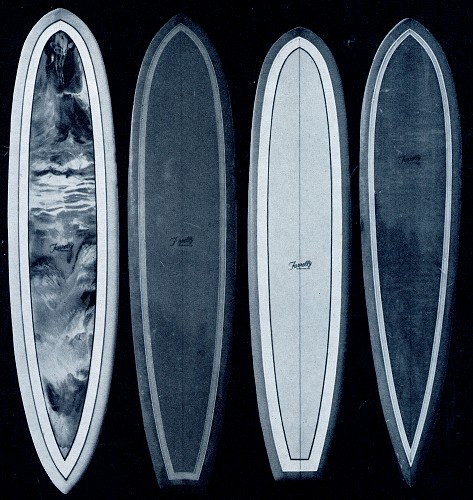
| Farrelly
Surfboards
c/o Palm Beach Post Office, NSW, 2108. Phone: 919-5169 |
All
models are
ultra-light and feature drag outlines and hi-lo gun
rails.
Various tints and colour designs of distinction available. Fins, area through various stages of low resistance speed fins. Cjhoice of hulls, flat or V. Interstate freight free. |
Page 17
ALBY FALZON interviewed Max on the subject of surfboards and design in his country.
Q. Max, why do you feel that the trend is changing from the wide V board to the narrow pintail?
A.
Generally the
widest part of the board is made one-third from the tail,
giving the maximum
planing area in this section.
With the
pintail
we have a complete reversal.
We now have
the
planing area one-third from the nose, thereby eliminating
excess board
in front.
Therefore,
the
major part of the board is now tucked back behind in the
curl, where it
is most needed to achieve maximum speed.
What's more, the shape of the
actual pintail is better suited to the shape of the curl.
Q. In
comparing
the shape of the "V" to that of the pintail one notices
fantastic differences,
especially in rail design.
What can you
say as regards this?
A. The high
and
low rail design is actually copied from the Hawaiian big
gun.
This means
that
the rail comes from high in the nose to low in the tail.
This gives
us
a sharper rail in the tail, which in turn affords us greater
planing area.
Q. I notice in your particular board you have a slightly weird combination of "V" and pintail.
A. Actually
what
I have evolved is a board that I refer to as a V-bottom
pintail.
People have
asked
me what the reason is for the fat "V" nose.
Well, I feel
that this enables us to maintain a tighter angle in the wave
and simultaneously
providing a good planing area in the nose.
Q. Your
particular
pintail has a rather thick and ugly-looking skeg.
Doesn't this
cause a certain amount of drag?
A. To
answer your
question, one has only to look at nature.
Let us, for
example,
take the wing of a bird.
Here we have
an object, which if one studies closely will be found to
have no flat surfaces
to create any drag.
I feel that
this
is what I am striving for, minimum drag anywhere on any part
of the board.
My skeg, as
you
will notice, has no flat sections.
Q. What do you feel about the rapid advancement which has taken place in the last few months?
A. As far
as I
am concerned there is always room for improvement on
anything.
The "V" was
a
big step, but while advancing many basic principles were
forgotten.
Page 18
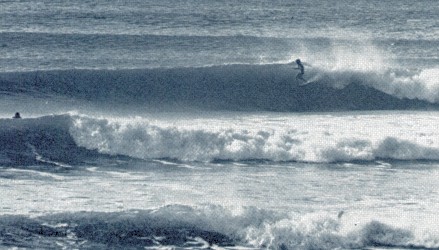
Jeffereys
Bay
Story by
Bob
Evans, photos by Alby Falzon.
Page 22
...
Within
twelve
hours the bad weather had passed, and the swell was pumping
thru regularly
on Noors Kloof Point, with a few sets touching 7 feet and
averaging 5 to
6.
The sun came
out; the breeze was a steady offshore north/wester at 15
knots.
Loopy Cerf
-Tony
van der Reuvel, Max Wetteland on their way-out mini-pins,
and twelve-year-old
Sean on his 5ft. 6in. vee-nosed mini-gun showed their paces,
and just how
far surfing performance in this country has come in the last
couple of
years.
The water
was
crisp at 60°, and apart from a couple of mating whales, plus
one curious
dark-skinned fisherman from the sandhills, the world was
ours alone.
The Indian
Ocean
stretched empty to the horizon and the mountains rimmed the
land, and touched
the sky with snowy fingers.
This was the
surfing life, the way we like it.
Page 26
I don't
surprise
easily- but the scene in the water at South Beach jetty was
a real bouncer.
The waves
were
: alive with radical performers drawing all kinds of crazy
tracks on the
smallest pintail units we had ever seen.
News travels
and surfers hereabouts had got the message and the story was
6' 6" to 7'
0"- fourteen pounds weight and radical as all hell.
In terms of
performance
and performers- Africa had arrived.
Strangely
enough-
or logically enough- many of the pressure merchants out
there riding were
Aussies.
Wollongong's
John
Batcheledore had just left Africa to return home- but his
mate Tony Wright
was turning on like he never had
at home in
Wollongong.
But Max
Wetteland
and Tony van de Heuvel and "Loopy" Cerf were the surprises-
there wasn't
a manoeuvre in the book that these African boys weren't
pulling off well.
Also just
along
the beach at a spot called Bay of Plenty (plenty of waves)
there was a
whole gang of youngsters, ten to fourteen years old, all out
there on little
five and six foot boards and these kids were really hot.
It seemed
that
one of them was even hotter than the rest, so we made a
point of meeting
him.
Not only was
he a talented surfer; but he turned out to be a young man of
exemplary
good manners and happy character.
His name was
Shaun Thomson, and he was twelve years old, and his dad was
Ern Thomson
and a good friend of Max Wetteland.
Ern and Max can honestly be said to
be amongst the finest of men over there.
Page 34
Advertisement (full page, black and white):
Page 40
Page 46
Advertisement
(quarter
page, black and white): Surf Beaches
of Australia's East Coast by Jeff Carter, $6.95.
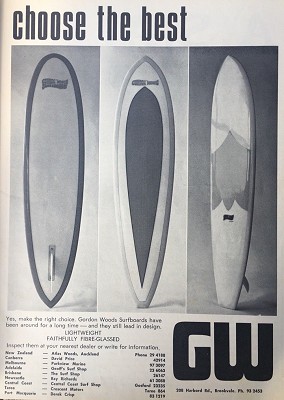 |
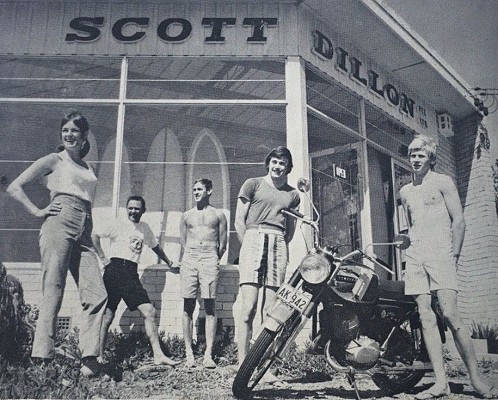 Scott Dillon and crew
advertising Baron Surfwear |
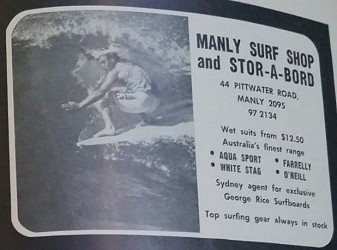 |
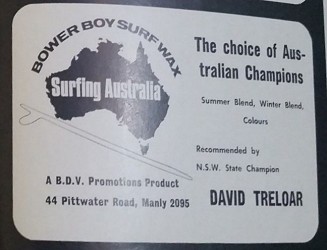 |
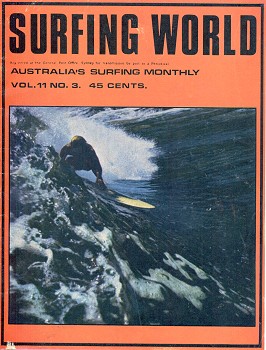 |
Volume 11. Number 3, August (?) 1968. |

| home | catalogue | history | references | appendix |